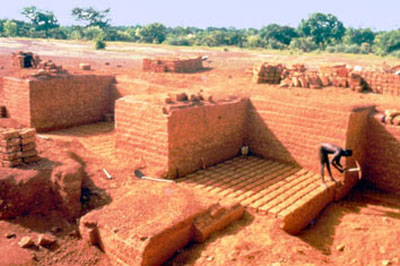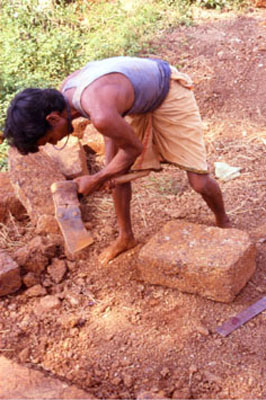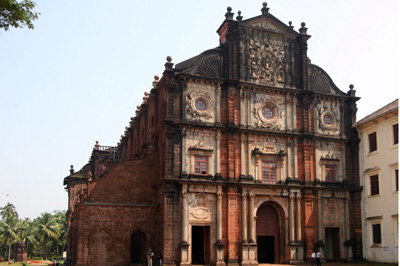Technique Overview
Cut Block
- Earth Dug Out
- Cut Blocks
- Earth Filled In
- Covered Earth
- Traditional Rammed Earth
- Modern Rammed Earth
- Compressed Earth Blocks
- Shaped Earth
- Stacked Earth (Cob)
- Adobe Moulding
- Adobe Buildings
- Extruded Earth
- Wattle and Daub
- Formed Earth (Straw Clay)
- Poured Earth
- Projected Earth
- Termite Wonders
- Views of Earthen Walls
In areas where the soils was cohesive and contained concretions of carbonates (a natural chemical which give cohesion) the soil was cut in the shape of blocks and used like bricks or stones. Such examples are found typically in tropical areas where lateritic soils give a wonderful building material.
Lateritic soils can be found in two natural states:
– Soft soils, which will harden when exposed to air due to chemical reaction of the soil constituent with the air (carbonation reaction). This natural reaction is called induration. Such soils can be found on the west coast of India, from Kerala to Goa.
– Hard crust which was long ago a soil and has already hardened (indured) through the ages. Burkina Faso in Africa and Orissa in India show wonderful examples of such soils and blocks.
Since a while the name laterite has been replaced by two more specific names: plinthite instead of laterite soft soil and petroplinthite for the hard crust laterite.
In areas where the soil is not cohesive enough, people have used topsoil and grass to create blocks which were stacked fresh upon each other. This method has been used a lot in England, where it has been named sod. In the early days of the United States of America, in South America as well as long ago in Scandinavia, sod blocks cut out of topsoil were extensively used. In Uruguay one can still see quite a few beautiful examples of sod buildings.





















Contact US
- Address:Auroville Earth Institute, Auroshilpam, Auroville 605 101 - T.N. India
- Phone:+91 (0) 413 - 262 3330 / 262 3064
- Email:info@earth-auroville.comOpens in your application

